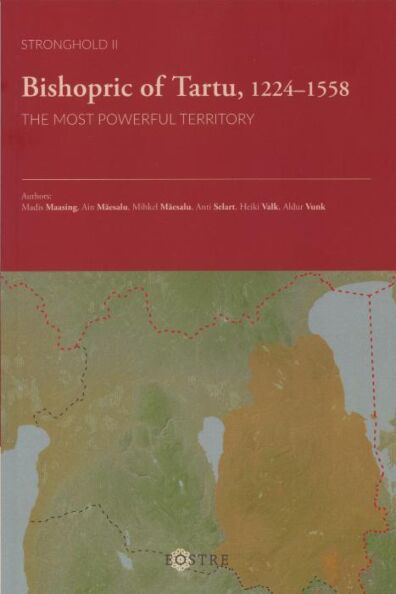Bishopric of Tartu, 1224–1558
Trükiviis 2024
Thus did Wennemar von Brüggenei, Land Master of the Teutonic Order, describe his opinion in 1400. Yet, the statement was true throughout the Medieval period: if the Bishop of Tartu supported the Teutonic Order, the Order's star in Livonia was on the rise, as the other bishops could not stand against the two. 17th century chronicler Christian Kelch kept this in mind when he described this territory as the most powerful in Livonia.
The bishopric which was created after the conquest of Tartu in 1224 lasted until 1558 when it surrendered to Russian troops. Thus did the «most powerful» fall as the first. How did the twists of fate, otherwise known as the choices of the bishop and his estates, lead to that outcome? What were the problems the Bishops of Tartu faced and how did these change throughout the Medieval period? These questions are answered through the reigns of the 27 known bishops and the power structures of the bishopric.
In addition to the history of the bishopric, the history and development of the town of Tartu, the principality's episcopal castles (Vana-Kastre, Kirumpää, Kastre, and Vastseliina), and feudal castles, the most well known of which is Rõngu, are described. The descriptions are supported by maps and reconstructions, taking into account the most recent archaeological surveys.
Thus did Wennemar von Brüggenei, Land Master of the Teutonic Order, describe his opinion in 1400. Yet, the statement was true throughout the Medieval period: if the Bishop of Tartu supported the Teutonic Order, the Order's star in Livonia was on the rise, as the other bishops could not stand against the two. 17th century chronicler Christian Kelch kept this in mind when he described this territory as the most powerful in Livonia.
The bishopric which was created after the conquest of Tartu in 1224 lasted until 1558 when it surrendered to Russian troops. Thus did the «most powerful» fall as the first. How did the twists of fate, otherwise known as the choices of the bishop and his estates, lead to that outcome? What were the problems the Bishops of Tartu faced and how did these change throughout the Medieval period? These questions are answered through the reigns of the 27 known bishops and the power structures of the bishopric.
In addition to the history of the bishopric, the history and development of the town of Tartu, the principality's episcopal castles (Vana-Kastre, Kirumpää, Kastre, and Vastseliina), and feudal castles, the most well known of which is Rõngu, are described. The descriptions are supported by maps and reconstructions, taking into account the most recent archaeological surveys.
| Tootekood | R0297575 |
|---|---|
| Aasta | 2024 |
| Autor | Mihkel Mäesalu, Ain Mäesalu, Anti Selart, Aldur Vunk, Madis Maasing, Heiki Valk |
| Sari | Võimukeskused |
| Kirjastus | Trükiviis |
| Kujundaja | Patricia Rodríguez Romero |
| Illustraator | Julia Lillo García, Rocío Espin Píñar |
| Koostaja | Koit Rikson |
| Köide | pehme |
| Lehekülgi | 228 |
| EAN | 9789916991893 |
| Ümbris | ei |
| Keel | inglise |
Kas kõik raamatud on kohe saadaval?
Uued raamatud - suur osa on laos olemas (seisukord>uus), aga suur osa on ka tellimisel (seisukord > uus tellimisel). Tellimisel raamatud saabuvad lattu enamasti 1-2-3 päeva jooksul.
Kasutatud raamatud (seisukord > väga hea, hea, rahuldav) on kõik kohe laos või poes olemas.
Mis siis teha, kui minu otsitud raamat on läbi müüdud?
Leia otsitav raamat täppisotsinguga siit.
Saada oma soov info@raamatukoi.ee. Me salvestame selle ja anname teada, kui raamatu
leiame. Vahel leiame kiiresti, vahel kulub aastaid. On raamatuid, mille järjekorras on mitu inimest.
Kuidas raamatud kätte saab?
Saadame raamatuid kõigisse pakikappidesse ja kulleriga otse tellija aadressile. Raamatuile saab ka ise kauplustesse järele tulla: Harju tn 1 Tallinnas või Lossi tn 28 Viljandis. Soome, Lätti ja Leetu saadame raamatuid nii pakikappidesse kui tavapostiga, mujale maailmas samuti tavapostiga. Loe lähemalt siit.
Millises seisukorras on kasutatud raamatud?
Iga kasutatud raamatu eksemplari juures on märgitud seisukord: väga hea, hea, rahuldav, halb ja vajadust mööda ka täpsustus. Loe lähemalt siit.

